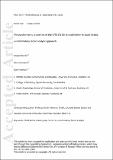Files in this item
The psychometric properties of the CFSS-DS for schoolchildren in Saudi Arabia : a confirmatory factor analytic approach
Item metadata
| dc.contributor.author | Alharbi, Amjad | |
| dc.contributor.author | Humphris, Gerald Michael | |
| dc.contributor.author | Freeman, Ruth | |
| dc.date.accessioned | 2020-03-04T00:31:54Z | |
| dc.date.available | 2020-03-04T00:31:54Z | |
| dc.date.issued | 2019-03-04 | |
| dc.identifier.citation | Alharbi , A , Humphris , G M & Freeman , R 2019 , ' The psychometric properties of the CFSS-DS for schoolchildren in Saudi Arabia : a confirmatory factor analytic approach ' , International Journal of Paediatric Dentistry , vol. Early View . https://doi.org/10.1111/ipd.12475 | en |
| dc.identifier.issn | 1365-263X | |
| dc.identifier.other | PURE: 257497740 | |
| dc.identifier.other | PURE UUID: 00494cd0-9c05-4268-8eb6-ffc8b8881f40 | |
| dc.identifier.other | Scopus: 85062520506 | |
| dc.identifier.other | WOS: 000471896600011 | |
| dc.identifier.other | ORCID: /0000-0002-4601-8834/work/64033858 | |
| dc.identifier.uri | https://hdl.handle.net/10023/19593 | |
| dc.description.abstract | Aim to test the psychometric properties of an Arabic version of the Child Fear Survey Schedule‐Dental Subscale (CFSS‐DS) a using confirmatory factor analysis. Methods 2 convenience samples were obtained: Sample [1]: 600 boys (33%) and girls attending 4 public schools in Onizah and Sample [2] 800 girls attending 8 public schools in Buridah. The questionnaire asked the participant's age, gender and completion of the CFSS‐DS. The data were subjected to exploratory factor analysis (EFA), parallel factor analysis, Cronbach alpha, confirmatory factor analysis (CFA) and goodness of fit statistics. Results 513 children in Sample [1] and 503 children in Sample [2] participated giving a valid response rate of 86% and 67% respectively. From the EFA 3 factors were identified and confirmed statistically using parallel factor analysis. The internal consistency of the 3‐factors, dental fear subscale (0.86); hospital fear subscale (0.77) and stranger fear subscale (0.71) was good. The CFA showed that the current EFA model was an equivalent fit to the El Housseiny et al1 model, however, the solution using El Housseiny et al's structure was distorted. Conclusions A 3‐factor structure with acceptable reliability exists for this Arabic version of the CFSS‐DS, confirmed by a CFA using an additional data set. | |
| dc.format.extent | 7 | |
| dc.language.iso | eng | |
| dc.relation.ispartof | International Journal of Paediatric Dentistry | en |
| dc.rights | © 2019 BSPD, IAPD and John Wiley & Sons A/S. This work has been made available online in accordance with the publisher's policies. This is the author created accepted version manuscript following peer review and as such may differ slightly from the final published version. The final published version of this work is available at https://doi.org/10.1111/ipd.12475 | en |
| dc.subject | Child dental anxiety | en |
| dc.subject | Confirmatory factor analysis | en |
| dc.subject | Psychometrics | en |
| dc.subject | RJ Pediatrics | en |
| dc.subject | RK Dentistry | en |
| dc.subject | NDAS | en |
| dc.subject.lcc | RJ | en |
| dc.subject.lcc | RK | en |
| dc.title | The psychometric properties of the CFSS-DS for schoolchildren in Saudi Arabia : a confirmatory factor analytic approach | en |
| dc.type | Journal article | en |
| dc.description.version | Postprint | en |
| dc.contributor.institution | University of St Andrews. Population and Behavioural Science Division | en |
| dc.contributor.institution | University of St Andrews. WHO Collaborating Centre for International Child & Adolescent Health Policy | en |
| dc.contributor.institution | University of St Andrews. Health Psychology | en |
| dc.contributor.institution | University of St Andrews. St Andrews Sustainability Institute | en |
| dc.contributor.institution | University of St Andrews. School of Medicine | en |
| dc.contributor.institution | University of St Andrews. Sir James Mackenzie Institute for Early Diagnosis | en |
| dc.identifier.doi | https://doi.org/10.1111/ipd.12475 | |
| dc.description.status | Peer reviewed | en |
| dc.date.embargoedUntil | 2020-03-04 |
This item appears in the following Collection(s)
Items in the St Andrews Research Repository are protected by copyright, with all rights reserved, unless otherwise indicated.

